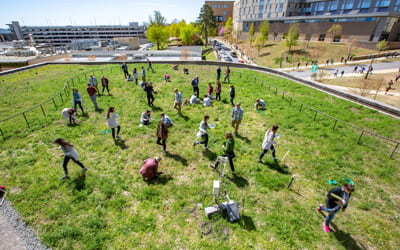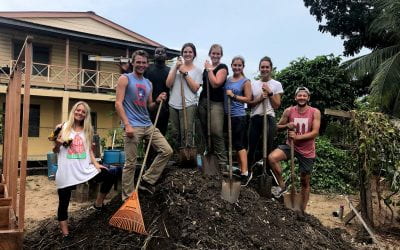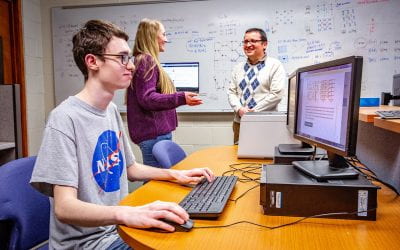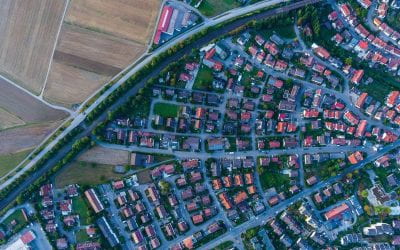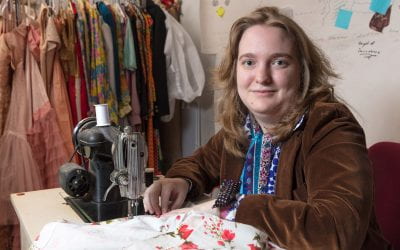
By Samantha Kirby
Photos by Whit Pruitt and Russell Cothren
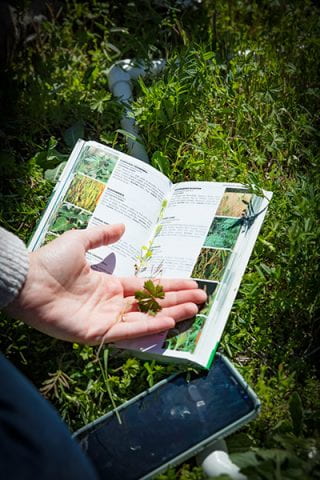

They’re strange bragging rights – but then again, it is a roof talking. And not just any roof – the U of A’s Hillside Auditorium green roof, which is exactly what it sounds like: a roof covered in about five inches of soil, atop which native plants have been growing since March 2013. The roof, affectionately dubbed “Rufus” by its student supervisors, has been tweeting measurement updates since early February 2019 via a Raspberry Pi microcomputer, thanks to senior Zack Wofford. Wofford was inspired by a tweeting tree he encountered while studying abroad in Ghent, Belgium.
“I felt that publishing the research on a live basis was an effective way of engaging the general public; I think folks find Rufus an entertaining follow. It’s kind of cute, a roof that is personified and tweets,” Wofford said. While most of Rufus’ updates have been about water retention and the green roof’s ability to lighten the load on the city’s storm water drainage systems, a team of students are measuring the roof’s efficacy in a variety of other subjects.
Juniors Elle Henson and Kanaan Hardaway, and seniors Eli LaSalle, Maddie Oxner and Zack Wofford, overseen by biological engineering professor Benjamin Runkle, have been collecting data on Rufus’s ecological and sociological impact for months, as the roof made its seasonal transition from a brown, spiky-haired winter lot to a lush mini-ecosystem. In the middle of it all sits what the students call Rufus’ “brain,” a very high-tech-looking array of devices, motors and microcomputers erected to measure variables such as solar radiation, wind speed and rainwater collection.
The project emerged out of another Honors College endeavor: the August 2018 intersession course Place in Mind, which took an abstract and mathematical approach to rethinking the Gearhart Hall courtyard, and by extension, public spaces at the university.
“After Place in Mind, we started researching new areas on campus where we could add something to the environment, and analyze the impact,” Henson said. “And we really dove into Hillside.”
Green roofs are undeniable boons to urban and semi-urban environments, decreasing the urban heat island effect by absorbing solar radiation and producing oxygen. Green roofs also provide a habitat for smaller species of plants and animals, particularly bug life. But where they really shine is in storm water regulation: green roofs absorb much of the runoff caused by a storm event, thereby lessening the load on the drainage system and allowing much of that runoff to be directed back into the natural water cycle. This is particularly beneficial here in Northwest Arkansas, where the hilly environment and clay soil further tax drainage systems.
Green roofs carry a sociological benefit, as well. A green roof offers a splash of color to offset the dreary grayscale of urban environments, and research shows that proximity to nature boosts mood and reduces stress. And reactions to the green roof are generally positive across campus, according to a survey conducted by Hardaway. His results are preliminary, he said, but “the clearest results of the questionnaire suggest individuals believe the benefits of green roofs outweigh the costs, and that more green roofs should be installed.”
More Field Notes
Model Garden to Boost Nutrition, Profits in Belize
A summer of beaches, tasty food, sunshine and a chance to serve. That’s the vision Zan Johnson, Bailey Carpenter, Natalie Zimmerman and Madison Ermert focused on as they tackled yet another pile of soil. Though the group anticipated unexpected adventures during the eight-week service-learning experience in Dangriga, Belize, they never dreamed of the sweat equity, sheer exhaustion and laughter that would accompany their journey.
Girl Power
Close to 40 fifth-grade girls are getting their ya-yas out as they try to maneuver an Oreo from forehead to open mouth – no hands allowed. The exercise invokes chaos, and more than a few cookies crushed underfoot, but the girls are quick to settle into a large circle anchored by Sophia Vincent, an honors education senior who easily commands the room.
Thin Tin
Two Honors College students have tackled – and solved – an important question about matter that sheds new light on the quantum world. Guided by mentor Salvador Barraza-Lopez, associate professor of physics, students Tyler Bishop and Erin Farmer have uncovered new information about tin oxide and have published their research in Physical Review Letters.
Rethinking Suburban Sprawl
David Sweere grew up in a classic American suburb in Maumelle, Arkansas, in a single-family home on a corner lot. He recalls a lot of lawn mowing and the fact that “you could see the Kroger grocery store from my house, but you couldn’t walk to it.” Fast forward through eight years of far-flung military service and six years of architecture school, and Sweere is ready to roll up his sleeves and redesign suburban sprawl.
On the Fashion of the Noldor in the First Age
Whether you’re a fan of Tolkien’s Middle Earth or have simply absorbed the cultural references it spawned (my precious…) you likely have a strong mental image of Tolkien’s characters. Galadriel, for example: Cate Blanchett, clad in white and silver, with flowing sleeves and Y-shaped fabric sash. Given the popularity of Peter Jackson’s film trilogy, that’s completely to be expected. But it’s also a problem, says Elkins native Grace Costello, who graduated in December 2018 with a degree in costume design from the Apparel Merchandising and Product Development program in the School of Human Environmental Sciences.
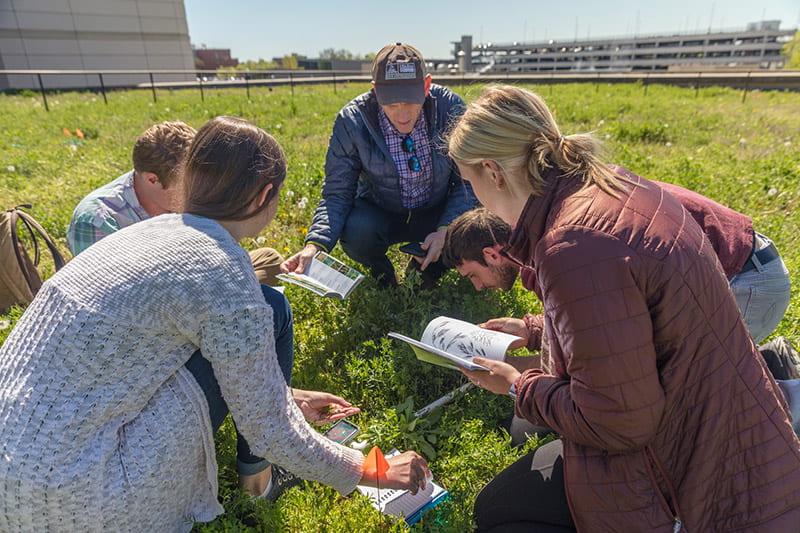
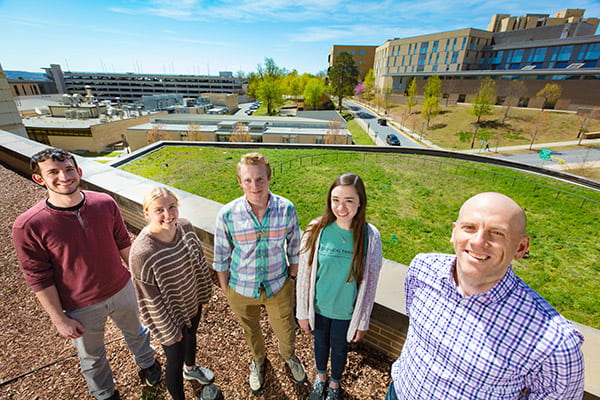
The green roof team includes (l-r) Kanaan Hardaway, Elle Henson, Eli LaSalle, Maddie Oxner and Prof. Benjamin Runkle.
“Green roofs are undeniable boons to urban and semiurban environments, decreasing the urban heat island effect by absorbing solar radiation and producing oxygen.”
Five years in, Rufus reflects the natural world of Northwest Arkansas. The roof was originally covered with native plants such as side-oats grama grass, but now, said Oxner, who is studying the biodiversity on the roof, native weeds such as dandelion and vetch have become interspersed among these plant species, further enriching the roof’s ecosystem.
These plants feed off a soil complex composed of 80% expanded clay and 20% mushroom compost. LaSalle is measuring the health of this soil by determining the rate at which it decomposes Lipton teabags, which serve as the official international scientific standard for this type of measurement. LaSalle has buried several teabags at varying depths on the roof itself, to compare their decomposition rates to a control group being decomposed in a laboratory setting.
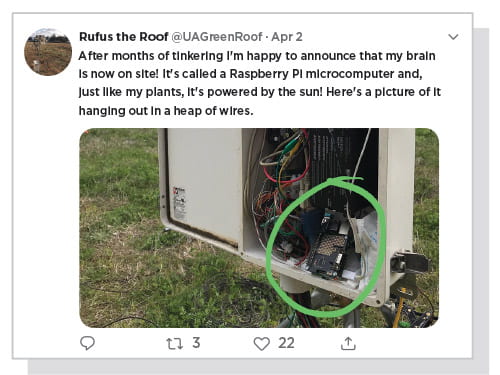 Henson is also focused on soil for her sustainability capstone project, using syringes to passively draw moisture directly out of the dirt. “Each one works as an artificial root,” Henson said. “I’m analyzing them for dissolved nutrients like ammonia, phosphate, chloride, nitrates and anions; I want to quantify how the green roof affects runoff.” In addition to soil nutrient levels, Henson is measuring evapotranspiration, or the rate at which the roof captures water and transfers it back into the atmosphere.
Henson is also focused on soil for her sustainability capstone project, using syringes to passively draw moisture directly out of the dirt. “Each one works as an artificial root,” Henson said. “I’m analyzing them for dissolved nutrients like ammonia, phosphate, chloride, nitrates and anions; I want to quantify how the green roof affects runoff.” In addition to soil nutrient levels, Henson is measuring evapotranspiration, or the rate at which the roof captures water and transfers it back into the atmosphere.
The research team hopes that their positive findings will help Hillside Auditorium serve as a model for other green roofs in the area. As for Rufus himself, there are no immediate plans to continue researching the area once the students are finished with their studies, but hopes are high that others will take up the baton. “It would be easy to incorporate a biologist here, or even an artist,” Runkle said. “As many people as can benefit from the roof and work with it, the better.”
Henson received a SURF grant to pursue this project; Hardaway an Honors College Research Grant; the three seniors an Honors College Team Research Grant. Follow Rufus on Twitter @UAGreenRoof

